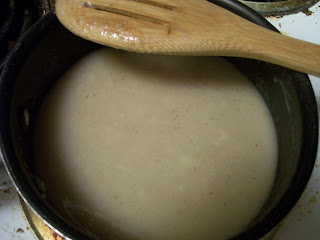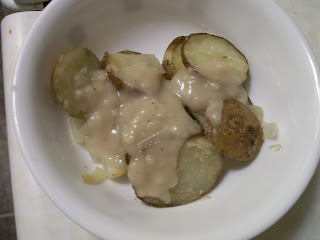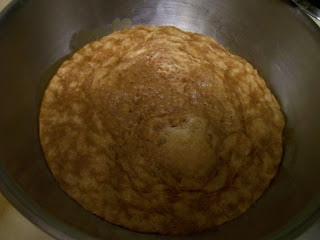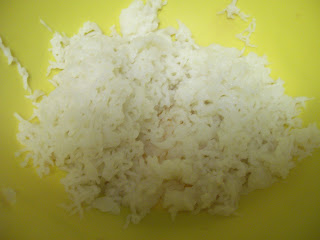The Challenge: Roasts.
The Receipt: Roast potatoes and onions from The Principles and Practices of Vegetarian Cookery (#230, pages 150-1) with brown sauce (#216, page 247). The sauce calls for ketchup; mushroom ketchup (#258, page 250) is the only ketchup receipt given in this book, though other types were also used in the period--Mrs. Beeton's has receipts for mushroom, walnut, or oyster ketchup. The sauce also calls for "browning" (#217, browned flour or powdered sugar with butter), though Cookery and Domestic Economy uses a similar sauce receipt, but with the "browning" optional, if the sauce needs to be darker. Since the receipt says a table-spoon is sufficient for a quart of sauce, and I'm not planning on making anywhere near that much, I think I'll follow the Cookery & Domestic Economy example, and not go to the trouble for less than a teaspoon of extra flour.
To Bake or Roast Roots, Tubers etc.
230. See 63 and 64. Prepare them as for boiling[#215/40: scrub the potato clean, possibly peel it, cut only large ones], and divide such as are very large; place them in a moderately heated oven, or in a Dutch oven, or cheese toaster; turn them occasionally, and take care they are not charred or burnt before they are well heated through. A small piece of skin may be cut off potatoes, and the remaining skin rubbed over with butter to make them crisp.
Large potatoes require about two hours; large beet root from four to six hours, When in haste, half boil the tubers and take off the thin skin before roasting them. Potatoes are improved by being roasted in wood-ashes. They may also be pared, put on a tin or dish, with two or three sliced onions, a little butter and water, and then a little flour dredged over them, baked in an oven, and served with brown sauce (516).
Brown Sauce.
516. (a.) Butter two ounces; flour one ounce. Melt the butter in a frying-pan or saucepan, add the flour and stir the mixture till it is of a brown colour; add as much boiling water as will render it of the consistency of thin cream; season with pepper and salt. Add a little browning and ketchup. (b.) Or, boil the flour and water with a little salt, then add it to the hot butter in the frying-pan add also browning (517) and ketchup (258), and let it simmer for five minutes, stirring it all the time."
Mushroom Ketchup.
258. Take two gallons of large flap mushrooms, quite sound; break them into a deep earthen pan and strew amongst them three quarters of a pound of salt, putting a little more at the top than between the layers. Let them stand one or two days and stir them gently once each day; drain off the liquor without pressing the mushrooms; strain and measure; it put it into a stew-pan and boil it quickly, with the seasoning until reduced to about one half. For every quart allow half an ounce of whole black pepper and a drachm [1/4 oz] of mace, or instead of the pepper a quarter of a tea-spoonful of good cayenne; pour the ketchup into a clean jug or jar, lay a folded cloth over it and keep it in a cool place until the next day; pour it gently from the sediment, put it into small bottles, cork them well, cover the corks with cement and keep the bottles in a cool dry place.Year/Region: 1860, British
How Did You Make It: I made the ketchup on approximately a 1:8 scale, and so took 8 oz of white mushrooms (I can find no references to clarify "large flap mushrooms"), layered them with 1.5 oz of salt, and let them sit for two days. About 1/2 cup liquid was recovered I added a couple dozen peppercorns and a pinch of mace, then boiled the liquid until reduced to 2 oz. I let it sit overnight, then poured off the liquid, straining it.
 |
| Preparing the mushrooms. |
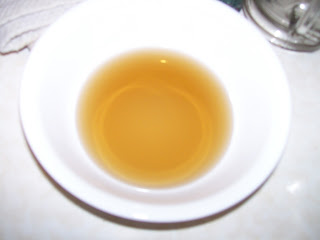 |
| Ketchup, ie spiced mushoom-liquid. |
I washed and sliced four potatoes and half a large onion, arranged them in a pan with 2 tsp of butter, 1/4 cup water, and a sprinkle of flour. Baked at 350F for about 75 minutes, until the potatoes were soft.
For the sauce, I melted the two ounces of butter as directed, sprinkled over it 1 oz of flour, and stirred it on moderate heat until brown. I then added a dash of pepper, and all of the ketchup. I added no salt, as the ketchup salty enough on its own (ie, the sediment strained off the ketchup was mostly salt crystals).
 |
| Onions and potatoes spotted with butter. |
How successful was it? Tasty. The sauce is a bit salty, but it's flavorful. The onions imparted a nice taste to the potatoes as well.
How accurate was it? The sauce is paler than "brown", as expected with the browning omitted. The treatment of the potatoes was a bit vague in the instructions, but I think I followed it reasonably. The substituted mushroom type has already been noted.

